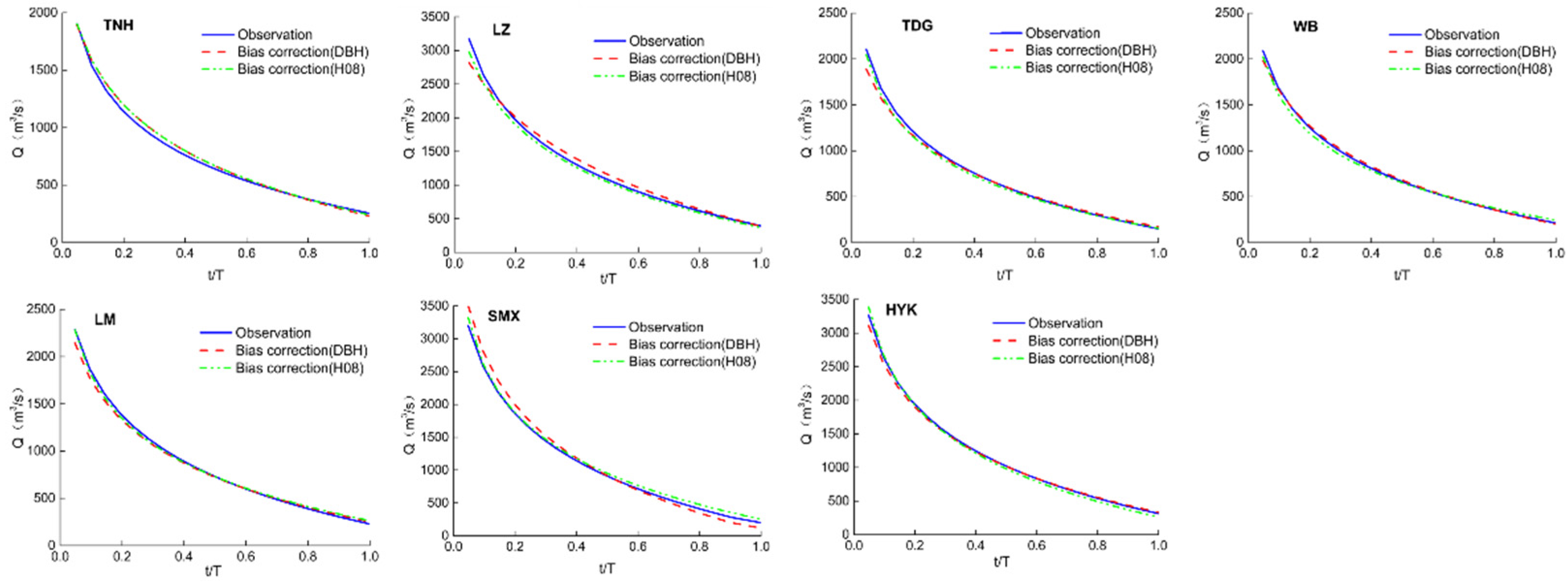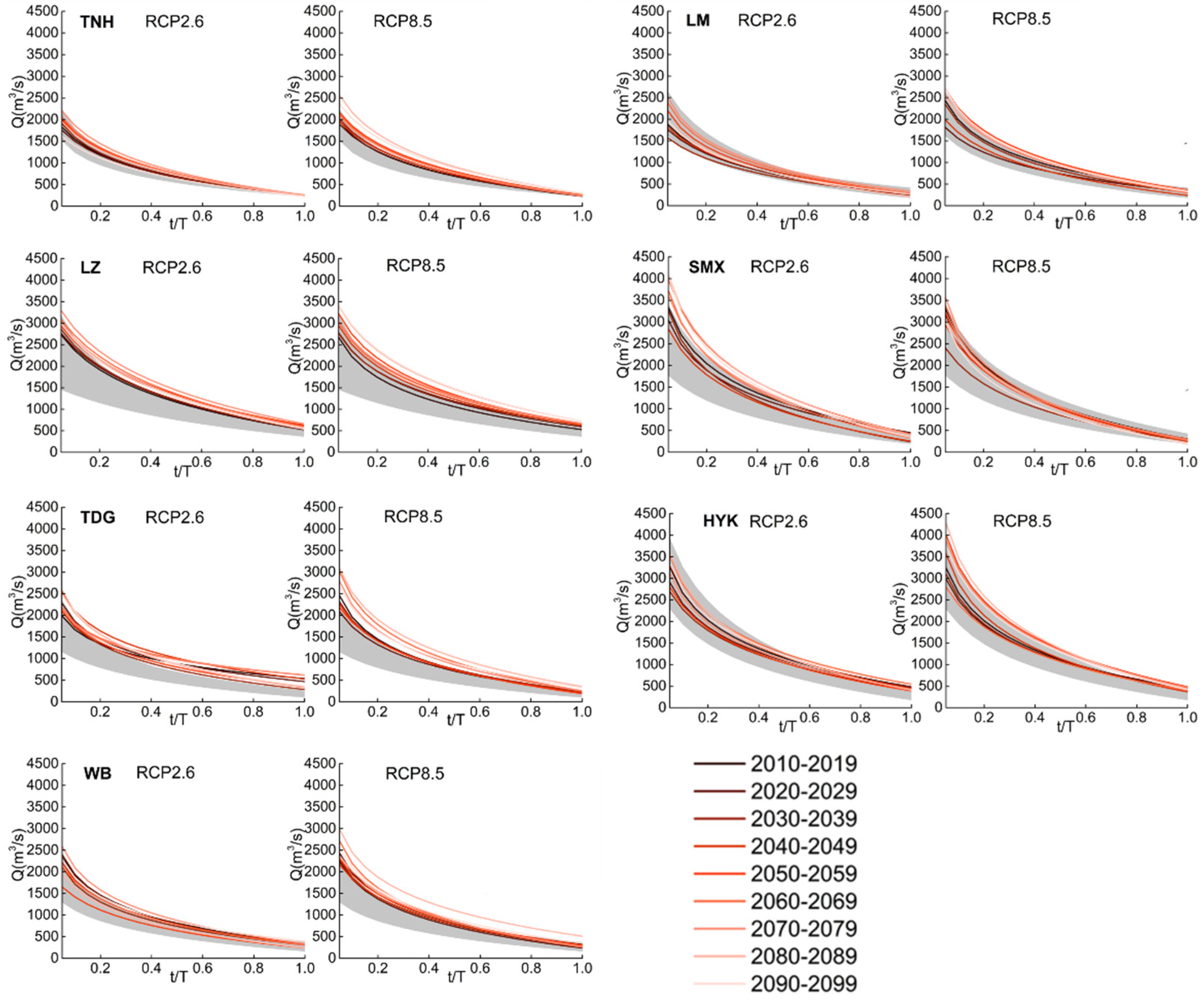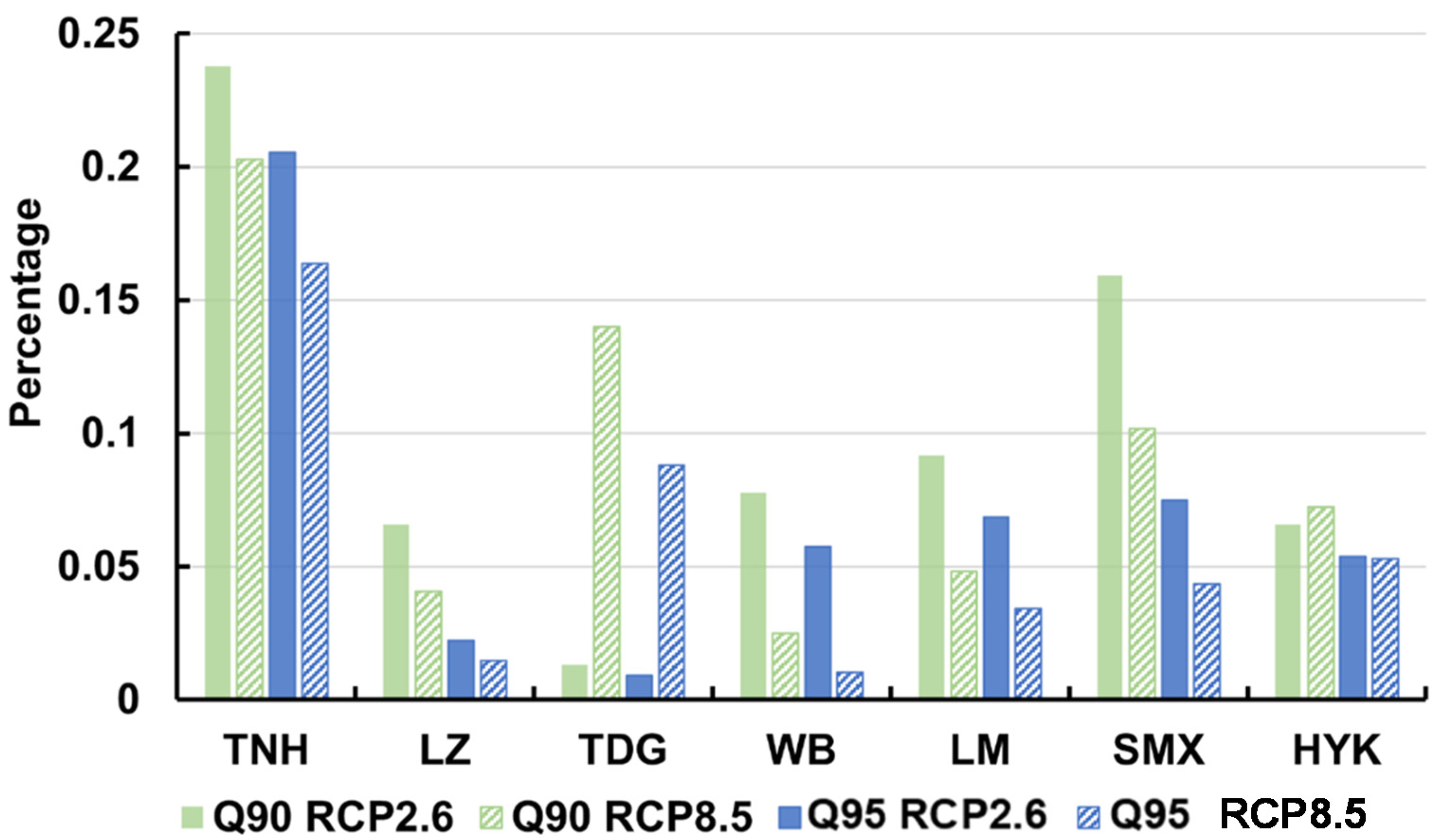Application of Entropy Method to Quantify Future Ecological Flow in the Yellow River Basin
Abstract
:1. Introduction
2. Methods
2.1. Entropy Theory
2.2. Entropy-Based Flow Duration Curve
3. Data
4. Results
4.1. Validation of FDC with the Observed Data
4.2. Prediction of Future FDCs
4.3. Predicted Ecological Flow
5. Discussion
6. Conclusions
- The simulated FDCs from the H08 and DBH models show good agreement with each other and fit observation well. The decadal FDC at each station is generally predicted to be higher or to stay in the higher range under both RCP 2.6 and 8.5 scenarios, implying a future increase in the volume of water.
- It is noted that the rates of increase in high flows and low flows are different, and at most stations, high flows increase much faster than low flows. As a result, the predicted FDCs have larger slopes than the references due to the larger M values in the future.
- At most of the stations, the future values of Q95 and Q90 will safely exceed the threshold. However, the number of days with flow lower than the threshold may be more than 5% and 10%, indicating a certain risk of ecological flow. It is found that there will be no or little threat to future ecological flow at the Lanzhou, Wubao, Longmen, and Huayuankou stations, but the ecological requirement is not always satisfied at the Toudaoguai and Sanmanxia stations.
- Water stress at the Tangnaihai station from the upper stream of the Yellow River may be threatened in the future. The FDCs of the Tangnaihai station show the least increase, with the number of days with flow lower than Q90 exceeding 20% and the number of days with flow lower than Q95 exceeding 15%, which is 2–3 times higher than the requirement. This indicates that water stress may be further exacerbated in the upstream area.
Author Contributions
Funding
Data Availability Statement
Conflicts of Interest
References
- Miao, C.; Ni, J.; Borthwick, A.G.L. Recent changes of water discharge and sediment load in the Yellow River basin, China. Prog. Phys. Geogr. Earth Environ. 2010, 34, 541–561. [Google Scholar] [CrossRef] [Green Version]
- Zheng, H.; Zhang, L.; Liu, C.; Shao, Q.; Fukushima, Y. Changes in stream flow regime in headwater catchments of the Yellow River basin since the 1950s. Hydrol. Process. 2006, 21, 886–893. [Google Scholar] [CrossRef]
- Yang, T.; Xu, C.-Y.; Shao, Q.; Chen, X.; Lu, G.-H.; Hao, Z.-C. Temporal and spatial patterns of low-flow changes in the Yellow River in the last half century. Stoch. Environ. Res. Risk Assess. 2009, 24, 297–309. [Google Scholar] [CrossRef]
- Zhang, C.-Y.; Oki, T. Optimal Multi-Sectoral Water Resources Allocation Based on Economic Evaluation Considering the Environmental Flow Requirements: A Case Study of Yellow River Basin. Water 2021, 13, 2253. [Google Scholar] [CrossRef]
- Fu, G.; Charles, S.P.; Chiew, F.H.S. A two-parameter climate elasticity of streamflow index to assess climate change effects on annual streamflow. Water Resour. Res. 2007, 43. [Google Scholar] [CrossRef]
- Yang, D.; Li, C.; Hu, H.; Lei, Z.; Yang, S.; Kusuda, T.; Koike, T.; Musiake, K. Analysis of water resources variability in the Yellow River of China during the last half century using historical data. Water Resour. Res. 2004, 40, W06502. [Google Scholar] [CrossRef]
- Tang, Q.; Oki, T.; Kanae, S.; Hu, H. Hydrological cycles change in the Yellow River basin during the last half of the twentieth century. J. Clim. 2008, 21, 1790–1806. [Google Scholar] [CrossRef] [Green Version]
- Ouyang, W.; Hao, F.; Song, K.; Zhang, X. Cascade dam-induced hydrological disturbance and environmental impact in the upper stream of the Yellow River. Water Resour. Manag. 2011, 25, 913–927. [Google Scholar] [CrossRef]
- Poff, N.L.; Zimmerman, J.K.H. Ecological responses to altered flow regimes: A literature review to inform the science and management of environmental flows. Freshw. Biol. 2010, 55, 194–205. [Google Scholar] [CrossRef]
- Sahoo, G.B.; Schladow, S.G. Impacts of climate change on lakes and reservoirs dynamics and restoration policies. Sustain. Sci. 2008, 3, 189–199. [Google Scholar] [CrossRef]
- Krchnak, K.M. Improving Transboundary River Basin Management by Integrating Environmental Flow Considerations. In Transboundary Water Resources: A Foundation for Regional Stability in Central Asia. NATO Science for Peace and Security Series C: Environmental Security; Moerlins, J.E., Khankhasayev, M.K., Leitman, S.F., Makhmudov, E.J., Eds.; Springer: Dordrecht, The Netherlands, 2008. [Google Scholar] [CrossRef]
- Tharme, R.E. A global perspective on environmental flow assessment: Emerging trends in the development and application of environmental flow methodologies for rivers. River Res. Applic. 2003, 19, 397–441. [Google Scholar] [CrossRef]
- Olsen, M.; Troldborg, L.; Henriksen, H.J.; Conallin, J.; Refsgaard, J.C.; Boegh, E. Evaluation of a typical hydrological model in relation to environmental flows. J. Hydrol. 2013, 507, 52–62. [Google Scholar] [CrossRef]
- Acreman, M.C.; Riddington, R.; Booker, D.J. Hydrological impacts of floodplain restoration: A case study of the River Cherwell, UK. Hydrol. Earth Syst. Sci. 2003, 7, 75–85. [Google Scholar] [CrossRef] [Green Version]
- Ferreira, R.G.; Silva, D.; Elesbon, A.; Santos, G.; Fernandes-Filho, E.I. Geostatistical modeling and traditional approaches for streamflow regionalization in a brazilian southeast watershed. J. S. Am. Earth Sci. 2021, 110, 103355. [Google Scholar] [CrossRef]
- Zhang, H.; Singh, V.P.; Zhang, Q.; Gu, L.; Sun, W. Variation in ecological flow regimes and their response to dams in the upper Yellow River basin. Environ. Earth Sci. 2016, 75, 938. [Google Scholar] [CrossRef]
- US EPA. An Approach for Using Load Duration Curves in the Development of TMDL. EPA-841-B-07-006; US Environmental Protection Agency, Office of Wetlands, Oceans, and Watersheds: Washington, DC, USA, 2007.
- Atieh, M.; Taylor, G.; Sattar, A.M.; Gharabaghi, B. Prediction of flow duration curves for ungauged basins. J. Hydrol. 2017, 545, 383–394. [Google Scholar] [CrossRef]
- Mitchell, W.D. Flow-Duration of Illinois Streams; Illinois Department of Public Works and Buildings, Division of Waterways: Springfield, IL, USA, 1957; 189p.
- Hickox, G.H.; Wessenauer, G.O. Application of duration curves to hydroelectric studies. Trans. ASCE 1933, 98, 1276–1308. [Google Scholar]
- Miller, C. Analysis of Flow Duration, Sediment-Rating Curve Method of Computing Sediment Yield; USA Department of Interior, Bureau of Reclamation: Denver, CO, USA, 1951.
- Searcy, J.K. Flow-Duration Curves. USGS Water-Supply Paper 1542-A; USA Geological Survey: Reston, VA, USA, 1959.
- Singh, V.; Byrd, A.; Cui, H. Flow duration curve using entropy theory. J. Hydrol. Eng. 2014, 19, 1340–1348. [Google Scholar] [CrossRef]
- Zhang, Y.; Singh, V.P.; Byrd, A.R. Entropy Parameter M in Modeling a Flow Duration Curve. Entropy 2017, 19, 654. [Google Scholar] [CrossRef] [Green Version]
- Yang, T.; Zhang, Q.; Chen, Y.D.; Tao, X.; Xu, C.-Y.; Chen, X. A spatial assessment of hydrologic alteration caused by dam construction in the middle and lower Yellow River, China. Hydrol. Process. 2008, 22, 3829–3843. [Google Scholar] [CrossRef]
- Yang, Y.-C.E.; Cai, X.; Herricks, E.E. Identification of hydrologic indicators related to fish diversity and abundance: A data mining approach for fish community analysis. Water Resour. Res. 2008, 44, W04412. [Google Scholar] [CrossRef]
- Ming-Xing, L.; Zhu-Guo, M. Spatial and Temporal Variability of Water Availability in the Yellow River Basin. Atmos. Ocean. Sci. Lett. 2013, 6, 191–196. [Google Scholar] [CrossRef]
- Zhang, Q.; Zhang, Z.; Shi, P.; Singh, V.P.; Gu, X. Evaluation of ecological instream flow considering hydrological alterations in the Yellow River basin, China. Glob. Planet. Change 2018, 160, 61–74. [Google Scholar] [CrossRef]
- Guo, Y.; Hou, S.; Lin, X. Variation characteristics of runoff and sediment in xiliugou river basin for recent 51 years. J. Arid. Land Resour. Environ. 2014, 28, 176–183. [Google Scholar]
- Shannon, C.E. A mathematical theory of communication. Bell Syst. Tech. J. 1948, 27, 379–423. [Google Scholar] [CrossRef] [Green Version]
- Jaynes, E.T. Information theory and statistical mechanics, I. Phys. Rev. 1957, 106, 620–630. [Google Scholar] [CrossRef]
- Luo, H.; Singh, V.P. Entropy theory for two-dimensional velocity distribution. J. Hydrol. Eng. 2011, 16, 303–315. [Google Scholar] [CrossRef]
- Cui, H.; Singh, V.P. Two-dimensional velocity distribution in open channels using the Tsallis entropy. J. Hydrol. Eng. 2013, 18, 331–339. [Google Scholar] [CrossRef]
- Cui, H.; Singh, V.P. One-dimensional velocity distribution in open channels using the Tsallis entropy. J. Hydrol. Eng. 2014, 19, 290–298. [Google Scholar] [CrossRef]
- Papalexiou, S.M.; Koutsoyiannis, D. Entropy based derivation of probability distributions: A case study to daily rainfall. Adv. Water Resour. 2012, 45, 51–57. [Google Scholar] [CrossRef]
- Cui, H.; Singh, V.P. Configurational entropy theory for streamflow forecasting. J. Hydrol. 2015, 521, 1–17. [Google Scholar] [CrossRef]
- Tsallis, C. Possible generalization of Boltzmann-Gibbs statistics. J. Stat. Phys. 1988, 52, 279–487. [Google Scholar] [CrossRef]
- Byrd, A.; Cui, H.; Singh, V.P. Tsallis entropy-Based flow duration curve. Trans. ASABE 2014, 57, 837–849. [Google Scholar] [CrossRef]
- Yin, Y.; Tang, Q.; Liu, X.; Zhang, X. Water scarcity under various socio-economic pathways and its potential effects on food production in the Yellow River basin. Hydrol. Earth Syst. Sci. 2017, 21, 791–804. [Google Scholar] [CrossRef] [Green Version]
- Piani, C.; Weedon, G.; Best, M.; Gomes, S.; Viterbo, P.; Hagemann, S.; Haerter, J.O. Statistical Bias Correction of Global Simulated Daily Precipitation and Temperature for the Application of Hydrological Models. J. Hydrol. 2010, 395, 199–215. [Google Scholar] [CrossRef]
- Cui, H.; Singh, V.P. On the Cumulative Distribution Function for Entropy-Based Hydrologic Modeling. Trans. ASABE 2012, 55, 429–438. [Google Scholar] [CrossRef]







| Stations | Location | Record Length | Annual Mean Streamflow (m3/s) | Lowest Value (m3/s) |
|---|---|---|---|---|
| Tangnaihai (TNH) | Upstream | 1961–2012 | 638.81 | 87.10 |
| Lanzhou (LZ) | Upstream | 1967–2012 | 941.48 | 285.58 |
| Toudaoguai (TDG) | Upstream | 1961–2012 | 618.41 | 65.55 |
| Wubao (WB) | Midstream | 1961–2012 | 667.42 | 68.68 |
| Longmen (LM) | Midstream | 1961–2012 | 732.50 | 120.17 |
| Sanmenxia (SMX) | Midstream | 1961–2012 (missing 2006) | 888.06 | 111.41 |
| Huayuankou (HYK) | Downstream | 1961–2012 | 1008.37 | 126.88 |
| Station | Qmax (m3/s) | Qmin (m3/s) | R2 * | |||||
|---|---|---|---|---|---|---|---|---|
| DBH | H08 | Obs. | DBH | H08 | Obs. | DBH | H08 | |
| TNH | 1890.49 | 1900.57 | 1904.07 | 231.22 | 240.16 | 254.07 | 0.899 | 0.895 |
| LZ | 2507.88 | 2504.04 | 2630.16 | 385.82 | 367.01 | 393.04 | 0.956 | 0.929 |
| TDG | 1887.16 | 2043.32 | 2102.30 | 170.11 | 155.06 | 150.27 | 0.896 | 0.864 |
| WB | 1980.74 | 2022.15 | 2086.77 | 200.51 | 245.91 | 212.53 | 0.908 | 0.865 |
| LM | 2144.30 | 2281.19 | 2287.47 | 251.14 | 262.73 | 227.78 | 0.889 | 0.868 |
| SMX | 3499.19 | 3320.21 | 3197.39 | 117.85 | 251.04 | 199.76 | 0.881 | 0.864 |
| HYK | 3116.28 | 3391.48 | 3268.97 | 331.53 | 262.17 | 313.10 | 0.885 | 0.866 |
Publisher’s Note: MDPI stays neutral with regard to jurisdictional claims in published maps and institutional affiliations. |
© 2021 by the authors. Licensee MDPI, Basel, Switzerland. This article is an open access article distributed under the terms and conditions of the Creative Commons Attribution (CC BY) license (https://creativecommons.org/licenses/by/4.0/).
Share and Cite
Wang, X.; Cui, H. Application of Entropy Method to Quantify Future Ecological Flow in the Yellow River Basin. Entropy 2022, 24, 72. https://doi.org/10.3390/e24010072
Wang X, Cui H. Application of Entropy Method to Quantify Future Ecological Flow in the Yellow River Basin. Entropy. 2022; 24(1):72. https://doi.org/10.3390/e24010072
Chicago/Turabian StyleWang, Xinru, and Huijuan Cui. 2022. "Application of Entropy Method to Quantify Future Ecological Flow in the Yellow River Basin" Entropy 24, no. 1: 72. https://doi.org/10.3390/e24010072
APA StyleWang, X., & Cui, H. (2022). Application of Entropy Method to Quantify Future Ecological Flow in the Yellow River Basin. Entropy, 24(1), 72. https://doi.org/10.3390/e24010072






